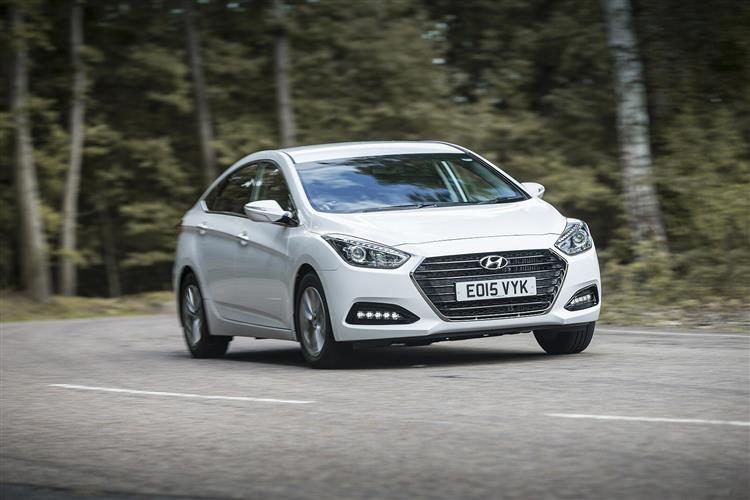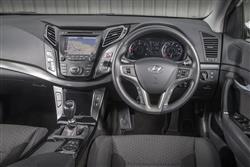LIFE CHANGING FORTY? (some text hidden) --NONE--
By Jonathan Crouch
Introductionword count: 90
If there was one truism with Hyundais of the past, it was that the bigger the car became, the less competitive it would be. The brand's i40 was a medium range Mondeo-sized challenger that back in 2011 aimed to comprehensively knock that kind of thinking into touch. Offering accessible pricing and plenty of space and equipment wasn't anything new for the Korean company back then, but the quality of finish and the maturity of the styling on offer here certainly was. Let's check out the i40 as a used buy.
Modelsword count: 13
4dr saloon and Tourer estate (1.6, 2.0 petrol GDI / 1.6,1.7 CRDi diesel)
Historyword count: 263
We don't tend to think of large Hyundais as being especially desirable - but with the i40, the South Korean maker was determined that we should. Their smaller models had always made more sense on paper than those of most rivals, but the larger and pricier a car becomes, the bigger is the role played by badge equity. Which, with this maker, had been slowly building prior to this car's 2011 launch as buyers realised this to be a brand beyond the bargain basement, a marque capable of producing tempting Mondeo-class medium range models like the i40. It certainly represented a big step up over its unremarkable Sonata predecessor. But that step needed to be seismic for Hyundai to get on terms with the Vauxhall Insignias, Volkswagen Passats, Peugeot 508s and Renault Lagunas that at the beginning of the 21st century's second decade were battling Ford's Mondeo in the medium range market. In a segment then splintering sales to People Carriers, Crossovers and MPVs, it was no longer enough simply to offer a 'good product'. Executive quality had become the norm, an attribute previously unfamiliar to Hyundai motorists. To be able to deliver this, as well as class-leading practicality and low running costs alongside more typical Hyundai virtues of strong value and high specification, was asking for quite a car. Still, the i40 had a decent stab at delivering on this brief. A 1.6 CRDi diesel engine replaced the original 1.7-litre unit in 2018. And the i40 range sold steadily until it was eventually deleted from the range in 2019 without being replaced.
What You Getword count: 396
'Fluidic sculpture' sounds as if it should create an elegant result. Here, it did. Heavily influenced by Hyundai's Frankfurt R&D centre, this was a design you'd never have seen from a Korean brand until 2011. The hexagonal front grille is shaped like a diamond, the headlights surrounding it modelled on those of a bird of prey and containing hook-shaped strips of LEDs that glow white in daylight. It's neatly styled at the rear too, with a smart chrome strip between the lights and an integral spoiler above the rear window of the 'Tourer' estate version. It's this estate that most UK customers tended to want rather than the alternative saloon variant, especially as Hyundai never bothered to offer a five-door hatch. Equal efforts were expended upon the stylised interior with its neat graphics, faux aluminium detailing, classy high-definition display screen and nice design touches. There's plenty of soft-touch plastic too, though that doesn't extend to things like the door-pulls and the door skins. Only the shiny column stalks remain as a reminder of the cheap-feeling Hyundai interiors of old. Finding an ideal driving position is easy, our only comment being that it's easy to bash your knuckles with downward gear changes when the central cup holders are in use. At the rear, there's comfortable space for two even with two six-footers up-front and room at a squash for three - pretty par for the course in this class: only a Mondeo or a Skoda Superb from the period offers more. Headroom's good, even if you're in one of the plushest models that have a huge panoramic glass sunroof fitted. It is though a pity that the thickness of the seat bases makes it difficult for rear seat passengers to slide their feet underneath. Any estate car stands or falls by the amount of gear it can carry and the i40 Tourer passes that test without breaking sweat. With the rear seats in place, there's a cavernous 553-litres available - more than you'd get in a comparable Ford Mondeo or Vauxhall Insignia - only estate versions of the Volkswagen Passat and Skoda Superb offer more. Drop the seats by simply pulling on the provided handle and pushing them forward and this will free 1719-litres to the car's head lining, though they don't fold completely flat and the space available is a little narrow between the wheel arches.
To see the full road test text contact us on 0330 0020 227
Pictures (high res disabled)

.jpg)
|
.jpg)
|
.jpg)
| |||
.jpg)
|
.jpg)
|
.jpg)
| |||
.jpg)
|
.jpg)
|
.jpg)
| |||
.jpg)
|
.jpg)
|

|
Scoring (subset of scores)
Category: Compact Family Cars
| Performance | |
| Handling | |
| Comfort | |
| Space | |
| Styling, Build, Value, Equipment, Depreciation, Handling, Insurance and Total scores are available with our full data feed. | |



